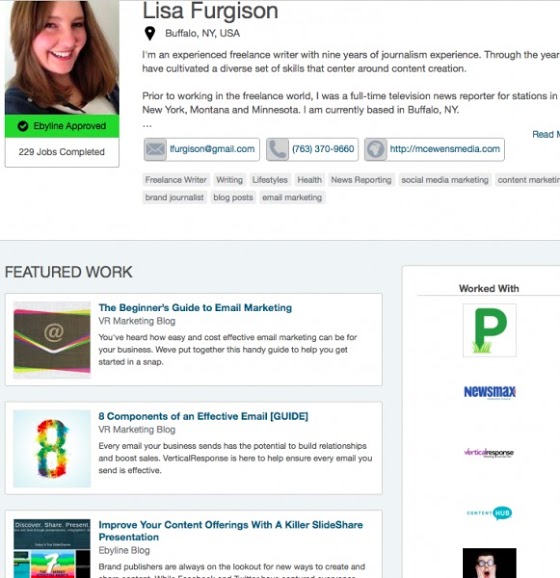As a writer, your content portfolio is the key to your continued success. Even if you write for a niche market, a diverse portfolio is the best way to impress prospective clients and showcase your skills.
Why is it so important to develop a portfolio that covers an array of topics? We turned to freelance writer Wendy Erlien and marketing specialist Aaron Abdelmaseh to weigh in on why a diverse portfolio can boost your business and to share some tips on the best ways to create one.
Show off your skills
Diverse content give you opportunities to impress both content directors and editors. Outside of those in the nine-to-five world, a growing number of writers find projects through virtual avenues. Many work through Skype and email and never meet their clients face-to-face. Some even pick up new projects by pitching clients on Twitter. Because of these unconventional methods, it can be more difficult to make a personal impression in the same way you would if you were personally interviewing for a job.
To make up for this disconnect, you want to showcase your diverse skills in a writing portfolio that screams, “I’m the writer you want.”
Increase your chances
Erlien says a diverse online portfolio is your ticket to more work.
“The opportunities for freelancers are endless,” she says. “A diverse online profile is a great way to not only showcase your work for potential employers, but to also potentially attract those interested in looking for a freelancer.”
These days it pays to be versatile, Erlien says. For instance, a marketing company that serves a variety of clients may want to bring on a writer who can create content for two different industries. If your portfolio lacks diversity, you might get passed over for another writer who has proven his or her ability to transition between topics.
Improve your SEO
 Aaron Abdelmaseh says diverse content is the best possible way to stay ahead of changes in the SEO game.
Aaron Abdelmaseh says diverse content is the best possible way to stay ahead of changes in the SEO game.A diverse portfolio can also improve your search rankings. If someone is in the market for a content writer, you want him or her to find your portfolio online with ease. Just like a business needs diverse content on its site to boost search results, so does your portfolio.
“By targeting narrow, specific keywords in the appropriate format in each piece of content, you increase your value to the reader as well as your value for ranking,” Abdelmaseh, founder of Ironworks Marketing, says.
In other words, a variety of content brings you a little SEO magic. If you’re floating to the top of the search results, even for what might appear to be obscure, industry-related terms, you’re more likely to get picked up than many other writers.
“And since Google is constantly changing its search algorithms, having a diverse range of quality content is the best possible way to stay ahead of changes in the SEO game later on,” says Abdelmaseh.
Improve your work habits
Writing about a variety of different subjects keeps you on top of your game, Erlien says. For example, if you sit at your laptop everyday and write how-to articles that focus on car repairs, you could get tired of the topic and feel like you’ve covered every possible angle.
It can be difficult to maintain the same content quality when you’re rehashing the same topic, so give yourself a mental break and work on covering themes that might not cross your desk every day.
Now let’s talk about how to diversify your portfolio.
Write for various fields
If you’re only writing for one specific niche, try branching out. It’s not always easy to crack into a different realm, but a good way to start is to write a few guest posts. Once the posts are live, add them to your portfolio to boost image as a writer who is able to handle multiple topics.
Since you don’t get paid for guest posts, it’s a good idea to do some preliminary research and find one that has a good following. That way when you do take the time to write an article, you’re more likely to get a boost in website traffic.
Add other media
It’s a good idea to include samples of other media too. Various media reaches differing audiences, so expect content directors to look for this when scrolling through your portfolio. Package content in several ways, Abdelmaseh suggests.
For instance, you might showcase both an article and a video that explains something like how to hang a porch swing.
“People’s search needs change based on their circumstances,” he says. “You want a very different result when you’re sitting on your couch and see a swing on a home improvement show than when you’re balancing on a ladder ten feet in the air. When you’re sitting, you might read a blog post. When you’re in the act of hanging one, you want a video.”
Multi-format content is a great skill to showcase; an employer is more inclined to take on a freelancer who is able to provide video, graphic design, and other skills in addition to their writing talents. Remember, businesses benefit from having diverse content portfolios too.
Cover the content bases
A diverse portfolio isn’t just about showing off a variety of different topics published on various channels; it’s also about writing different kinds of content. From how-to articles to in-depth guides, you want a trail-mix of content. Abdelmaseh offers this quick list of content types that your portfolio should include:
- How-to pieces
- Industry and influencer interviews
- Best practices
- Worst practices and how to avoid them
- Tips and tricks
- Q & A
- Lists
- Opinions/advice columns
Use the right tools
Now that we’ve covered why you need a good mix of content, let’s talk about some easy-to-use tools that can help you create a the diverse portfolio you need. You want a portfolio that’s visually appealing, easy to navigate and shows off your best work. Here’s a quick list of sites that can do just that.
With Ebyline you can create an appealing, professional portfolio. Plus, it’s a great marketplace where you can pick up projects that cover a huge swathe of topics. As you can see below, you can upload your picture, create a brief description about your work, list your contact information and create a visual list of featured work.
You also have the option to add a site that you write for and Ebyline will pull several samples into your portfolio. You’ll even get an email with a list of recent articles that you’ve written. With a few simple clicks from the email, you can upload those samples too.
Plus, it’s free and you get access to a jobs board where you can apply for writing projects.
Pressfolios has a visually appealing portfolio set up. It has cover art, much like Facebook. You can showcase up to 12 stories for free, but if you want more, you’ll need to upgrade to the $11.99/month plan. You can upload PDFs or links to your account, all of which is ultimately backed up on the cloud.
Squarespace is a popular website-building tool that many writers use to format an entire website with a portfolio as a main feature. It does require a subscription fee; the cheapest option is $8 a month, but there are many of easy-to-use templates that even the least savvy website designers can use. Here’s an example of one of the pre-filled templates.
Erlien uses LinkedIn to showcase her writing samples. As you can see, the site offers her a unique combination of an online resume and a way to highlight her work. Plus, a large number of professionals use LinkedIn to find freelancers, so it’s worth exploring.
It’s an especially smart option if you plan to use LinkedIn to publish content. This social site is no longer just a resume placeholder; the company has upped its game recently. Now you can not only advertise your background and connect with others, but you can also write the equivalent of blog posts that are attached to your profile. If you plan to use this feature, LinkedIn is certainly worth exploring as a portfolio option.
In the end, it’s a good idea to cover a number of themes in your work. Diversifying your portfolio will “generate more leads, create better awareness about your skills and ultimately bring in more business,” Abdelmaseh says.
So, how will you diversify your portfolio? Tell us in the comment section below.








